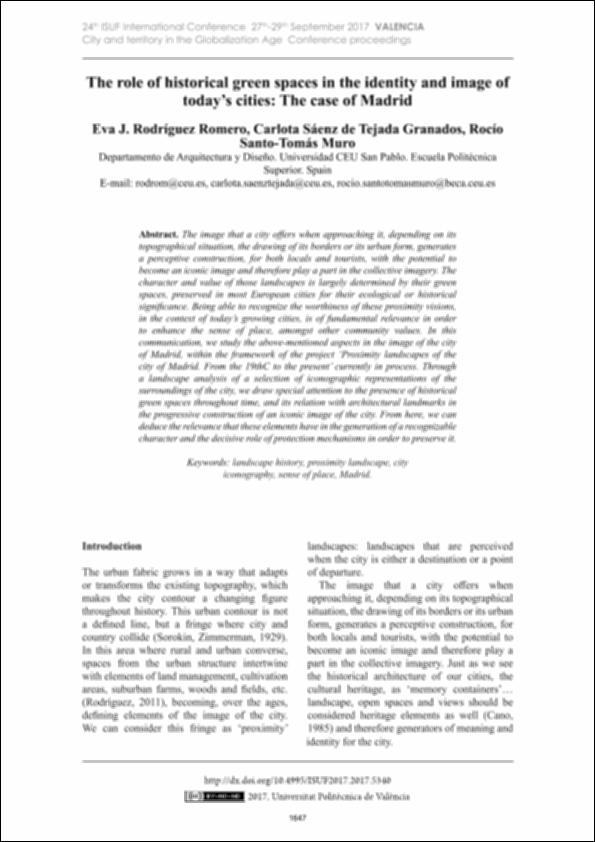Please use this identifier to cite or link to this item:
http://hdl.handle.net/10637/14368The role of historical green spaces in the identity and image of today?s cities: The case of Madrid
| Title: | The role of historical green spaces in the identity and image of today?s cities: The case of Madrid |
| Authors : | Rodríguez Romero, Eva Juana. Sáenz de Tejada Granados, Carlota Santo-Tomás Muro, Rocío |
| Keywords: | Landscape history; Proximity landscape; City iconography; Sense of place; Madrid |
| Citation: | Rodríguez Romero, Eva J., Sáenz de Tejada Granados, Carlota, Santo-Tomás Muro, Rocío: ‘The role of historical green spaces in the identity and image of today’s cities: The case of Madrid’, in VV.AA. ISUF 2017 XXIV International Conference: City and territory in the globalization age, Universidad Politécnica de Valencia, 2017, pp. 1647-1656 |
| Abstract: | The image that a city offers when approaching it, depending on its topographical situation, the drawing of its borders or its urban form, generates a perceptive construction, for both locals and tourists, with the potential to become an iconic image and therefore play a part in the collective imagery. The character and value of those landscapes is largely determined by their green spaces, preserved in most European cities for their ecological or historical significance. Being able to recognize the worthiness of these proximity visions, in the context of today’s growing cities, is of fundamental relevance in order to enhance the sense of place, amongst other community values. In this communication we study the above-mentioned aspects in the image of the city of Madrid, within the framework of the project ‘Proximity landscapes of the city of Madrid. From the 19thC to the present’ currently in process. Through a landscape analysis of a selection of iconographic representations of the surroundings of the city, we draw special attention to the presence of historical green spaces throughout time, and its relation with architectural landmarks in the progressive construction of an iconic image of the city. From here, we can deduce the relevance that these elements have in the generation of a recognizable character and the decisive role of protection mechanisms in order to preserve it. |
| URI: | http://hdl.handle.net/10637/14368 |
| Rights : | http://creativecommons.org/licenses/by-nc-nd/4.0/deed.es |
| Issue Date: | 2017 |
| Center : | Universidad San Pablo-CEU |
| Appears in Collections: | Escuela de Politécnica Superior |
Items in DSpace are protected by copyright, with all rights reserved, unless otherwise indicated.


